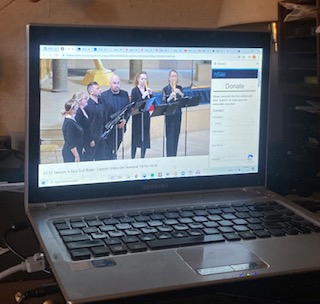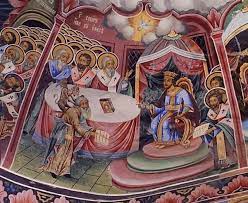Once the upstart child of the early-music counterculture, Piffaro, the Philadelphia Renaissance Band is now, at age 40, downright venerable, as its founders are ceding leadership to a generation who learned about pre-Bach wind band literature by memorizing their recordings. Starting next season, Priscilla Herreid moves up from the ranks as the new director, replacing Joan Kimball and Robert Wiemken, who have jointly been given a lifetime achievement award by Early Music America. The world never asked for a Renaissance wind band, but Piffaro delivered one at the highest musical standard without ever running out of new ways to redefine our times through the lens of long-ago centuries.
The success of its most recent concert in Philadelphia (available on demand until Oct. 26 through piffaro.org) wasn’t about an old guard/new guard change but the accumulation of ideas (reaching back to the fifth century) during lockdown and the emergence of the vocal group Variant 6 as a significant early and modern music ensemble.
The currents that came together in the Oct. 8 concert, titled A New Sun Rises (and which I viewed online last weekend), included the music of cloistered nuns who composed against the wishes of the Vatican and the world premiere of Ave Maris Stella by Kile Smith, the Philadelphia-based composer who happens to be Herreid’s father. That fact doesn’t point to intra-Piffaro nepotism: Smith’s relationship with Piffaro began in 2008 with his Vespers, premiered in collaboration with The Crossing choir and a breakthrough for all parties concerned. A return engagement with Smith was overdue and was no doubt in discussion for years. In addition, guest cornetto player Kiri Tollaksen made a great impact throughout but especially in the cornetto/lute duet “Diminutions on Io canterei” by Giovanni Bassano (c.1561–1617). Elsewhere, the exotic blends of Piffaro’s ancient instruments have never felt more airy or alluring.

viewed on my laptop
Was there an intentional parallel between programming the music of cloistered nuns and our emerging from lockdown? Well, the composers also happen to be women, and ones whose music I’ve enjoyed over the past 12 years or so as excellent examples of what was written in the era of Monteverdi but with what seems like an especially unmediated mode of expression intended for non-public musical meetings among friends. Of the two such composers represented here — Vittoria Aleotti (c.1570–after 1620) and Raffaella Aleotti (c.1570–1646) — only Vittoria is a documented cloister dweller. They may have been sisters or possibly the same person.
Each published a single collection of music. The last two pieces from each one, included on the Piffaro program, don’t sound like the work of different composers, though the sense of a “lingua franca” in this period was so strong that one can’t expect to clearly differentiate two contemporary personalities.
Both pieces are quite secular. Vittoria wrote both text and music to “Io v’amo vita mia” a piece that candidly expresses deep longing and passion. Raffaella’s “Surge, propera amica mea” convincingly encompasses a wide emotional range that is clearly the work of a highly accomplished composer — especially when sung with the tight chord tunings and stylistic finesse of Variant 6.
A modern pendant to those pieces was Alma redemptoris mater by Cecilia McDowall (b. 1951), which was also in keeping with the concert’s theme of rebirth. The piece begins with individual voices having their own awakenings in a mildly ornate, possibly Arabic-influenced language, and coming together in harmonies that were ultimately all the more penetrating for being austere.
Smith’s Ave Maris Stella is a world (at least) away from his lyrical, devotional but joyful Vespers. Brass play a significant role here, and Smith’s opera-in-progress based on the Book of Job hovers behind the scenes, lending the piece a sense of dramatic subtext and three-dimensional gestures. In his notes, Smith zeroed in on a theological debate at the fifth-century Council of Ephesus (in present-day Turkey) in which the Church-approved reference to the Blessed Virgin Mary was under discussion. Is she the mother of God (which was traditional at that time) or the mother of Jesus? The question may seem abstruse to us, but it’s tied directly to the debates over the divinity of Christ that rocked the early centuries of Christianity. “The people were having none of it” wrote Smith in his program notes. “They chanted Hagia Maria Theotokos, ‘Holy Mary, the Bearer of God’ in the streets while the Council met. The effect of their protest is unknown, but the picture of bishops wrangling over theology with vox populi, vox Dei ringing in their ears is an enticing one.”

That element isn’t explicitly dramatized in his music, but that tension and turmoil is felt in different ways almost throughout the piece. The most common thread among the seven movements is compact, homogeneous vocal writing that carries inner tensions but sits like an island of belief standing apart (but not departing) from the larger world. So tight was the Variant 6 blend that the textures sounded almost electronic at times. Canonic writing gave a sense of introspection — in contrast to brass writing that framed the piece with fanfares that seemed to call to each other from a distance.
But really, little generalizing can be done about this piece because each movement is its own musical world, the most intriguing being a trio of male voices whose only accompaniment is an endlessly inventive recorder solo. Yes, I’m still coming to terms with Smith’s latest work, but I wanted to get a provisional review posted before the concert’s on-demand availability expires.
Just for the record, the video element in this streamed presentation has evolved enormously from previous Piffaro outings, with effective camera work shot amid the clean, uncluttered architecture of the Philadelphia Episcopal Cathedral.
For further information; piffaro.org.

